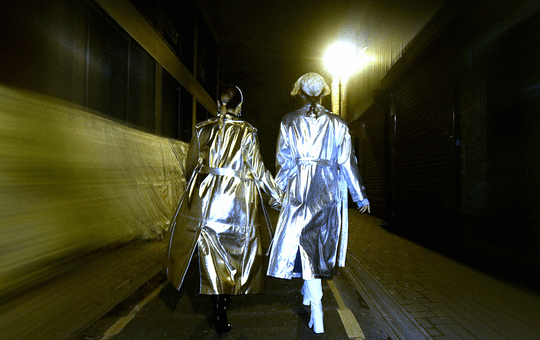
Technique: The Range - Potential
Put simply, without YouTube, The Range's second album 'Potential' would not exist as it does. For the follow-up to his 2013 debut 'Nonfiction', James Hinton grabbed a digital passport and took a journey into the hidden recesses of the site to discover new sources to sample for the project. While mining for sounds, Hinton found several favourite videos ranging from covers, original compositions, and freestyles that were all unified by the same bond: they were barely viewed or heard, and otherwise unknown to the rest of us.
Of course, YouTube crate digging or sampling is by no means a novel concept in musical composition. Usually, when an artist samples vocals, they bring in voices that coincide with their views and allow them to speak on behalf of the author. That is not the case with 'Potential'. Hinton is not the leading voice; he mediates the messages of these minorities, and these varied narratives are the essence of what makes the album unique. Jordan Lardizabal, Ophqi, ST, Kruddy Zak, Damian Gordon, Frank Cole – these are the characters whose voices and personal stories you hear across 'Potential'.
Although the people speaking for Hinton are distant to us, the subjects concern universal themes to which we can all relate. The music, too, is familiar, and the songs on 'Potential' combine the same elements of grime, dubstep, and, electronica, sharpening what Hinton started on 'Nonfiction' into a fully realised statement. The opening song Regular repeats a refrain of an ominous line that goes, "Right now, I don't have a backup plan for it I don't make it." On the whole, 'Potential' is largely a record of positivity and optimism, though this opening caveat would have you believe you've stumbled down the dark web with Hinton. Sonically it can sound dark, but there are moments of outright euphoria (Copper Wire and Florida) and an undercurrent of mindfulness that stays elevated above any creeping negativity.
Ahead of its release tomorrow – and a forthcoming documentary about the collaborators on 'Potential' – there was only one person that could explain what the messages and sonics of 'Potential' mean. As such, in this detailed track-by-track guide, James Hinton outlines the composition and creative process behind what is certain to be one of 2016's most singular releases.
1. Regular
James Hinton: "Regular is the most sparse construction of any song on the whole album. I think the bare percussion against the vocal – which is way up the mix – helps set up the bass and takes up a huge amount of the energy when it finally comes in. It also helped to send each element to a radically different reverb time so that they were occupying their own space and add an intensity when each successive element came in. I also remember spending lots of time setting the midi glide of the bassline when I was writing, so it had just the right amount of attack at each transition as it seemed to be really sensitive to the whole composition."
2. Copper Wire
James Hinton: "Copper Wire is the first time on the album you hear the big stereo version of a Reece bass which makes an appearance on a few songs on this record. I became really obsessed with using this sound underneath a lot of the production because of its unique ADSR profile. It has so much intensity when played with any syncopation but becomes anthemic (which I had intended for this song) when played with any sustain. The other challenge with this song was that the original video of Zak has all sorts of jacket-rustling and wind noise in the background, so there was a time-intensive part that I spent trying to make the vocal part consistent with itself as I reordered a lot of the phrases around from the original."
3. Florida
James Hinton: "Florida went through many iterations along the way to end up how it is now. It started out as a percussion workout alongside the steel drum, and over time, I stripped away a lot of the patternation to create a (relatively) cleaner opening. I think this is a great example of the energy that the syncopated version of the Reece bass has too; it helps the song feel like it's making a leap into every chorus when that line hits."
4. Superimpose
James Hinton: "Superimpose was about getting the bassline together. I think there are about five different sounds that are stacked up to make the sound. I like that it still sounds harmonically rich even though all of the composite elements are supremely hollow sounding. By building up the bass that way, it allowed me to access the subtle tonal shifts I wanted to achieve in the harmonic structure of the bass notes. By having the bassline become increasingly harmonically rich over time, it provides a blossoming effect alongside the additional chopped pads and arpeggios that come in by the end, but it still allows for the opening to be as spare as I wanted it to be."
5. Five Four
James Hinton: "I love the chopped piano opening of Five Four and how the chops hit the reverb for a crackle effect. I think it helps build the intensity into the vocal which I wanted to present pretty spare to start. A lot of what interested me at the time of finishing this song was how to try to jump off at the point where the delayed Ophqi ‘boh!’ sample hits. The vocal intensity is already so high, and the key was on the pad that hits just after the gap of sound from the Ophqi sample, and the delayed plucks from a big tape machine. Listening back now, it helps lift the ending into an ethereal place that still has a ton of momentum to my ear."
6. Falling Out of Phase
James Hinton: "Falling Out of Phase has some of the most in-depth vocal processing despite the relatively short length of material used from the original video. I think that was one of the most rewarding parts of the whole process on this record; Youtube compression inherently comes with every piece of material I worked with, and it was fascinating to discover tricks to deal with that along the way.
On this song, there are high and low pitched versions of the original used and each required a different treatment from the beginning. There are different vocal chains and treatments of the formant on and a little more liberal eq-ing out of the environment in the higher version. I think it was interesting to think through that issue as in the studio I would just sing the low part and high part, but because you only have one take, it makes some interesting situations that I think betters the overall composition."
7. No Loss
James Hinton: "My favorite part of No Loss is when everything hits a little after the two-minute mark. The drum break and the bell started out compressed, so I think it's a nice counterpart to have the open harp and the choral voices against that. I also think having all of the various timbres complete each other’s melodic lines in that section was something I worked on for a long time while mixing the final section of this song as the opening is very much straight up and down counterpoint."
8. Skeptical
James Hinton: "Skeptical is a track where, because of the length of the vocal loop, I was attempting to make the music shift the ground over time to recontextualize the vocal line. The opening was mixed sparsely to have the baseline and percussion elements explicitly fight against each other rhythmically, and I try to peel back that brash feeling over the course of the opening. Skeptical is another case where I used a tape machine emulator pretty heavily in the back half of the song on a lot of the layers to help kick off the final section; I find that it helps have a much more unified feeling, particularly against the opening palette."
9. Retune
James Hinton: "This song also heavily used a lot of the formant and pitching techniques I talked about with Falling Out of Phase. I was taking single words and would treat the same word differently depending on if it completed a phrase or was left bare. A great example is the repetitive use of the word "be" – I tried to match the bes that completed the phrase ‘Admit You’ll Be’ differently than when they were out in the open. This song is also one of the heaviest piano songs on the whole album (I was in a huge BWV phase at the time), so I had to make sure to use the stereo field to avoid phase problems as a lot of the pianos are hand-on-top-of-hand."
10. So
James Hinton: "So has some of my favorite internal production on the record in that overall I think it sounds natural, but there is a little web of internal side-chaining throughout this song that I spent a long while tuning. So often, sidechaining can be overblown, but I found with this set of songs that I have elements that I wouldn’t normally think to tie into one another – by attaching them with a side-chain, or by muting the source material so that you couldn’t hear it but were left with the residual effect on the target channel. I think the song is lively then but not in a way that you would normally attach to that effect, which I am very happy with now that I have some distance from the finishing process."
11. 1804
James Hinton: "I think the most notable piece of this song is the pianos at the end. I had a sketch of 1804 pretty early on in the process for recording 'Potential', and I knew that there needed to be a second reprise section that was different than the opening. One day I left the piano fourths from the opening going, which suggested that there could be room for more piano work. I remember belaboring the composition and struggling with the voice leading right up to 4 AM the day before I had to leave London (I live in New York but was finishing up mixing the album at Konk Studios in Crouch End).
I distinctly remember the moment of horizontally shifting and doubling one of the fast piano micro lines right by accident and all of a sudden magically everything fell into place, which always seems to happen to me. Now when I listen to this song, I always think it has a degree of spontaneity and urgency, but it also reminds me to be hopeful for the future – this is one of my favorite parts of the album."
The Range's 'Potential' is out March 25th through Domino Recording Co Ltd (pre-order).













